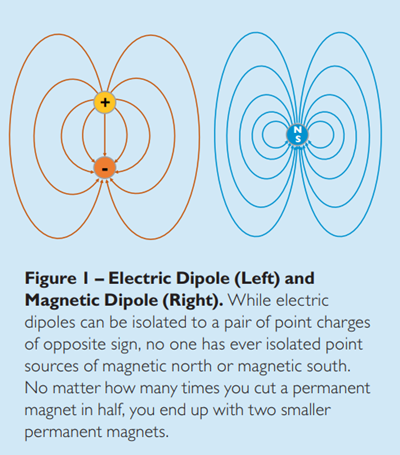Dielectric materials have electric dipoles, which are atoms or molecules with positive and negative charges at opposite ends. The number and behavior of these dipoles determine the dielectric properties of the material. Materials also have magnetic dipoles, which determine their magnetic properties. Magnetic materials are often subdivided into regions where the dipoles tend to share the same alignment. These regions are known as domains. Note that there may be many such domains within a single crystalline grain within the material.
In a dielectric material, the electric dipole moment arises from the electric field created between the positively charged end and the negatively charged end. In a magnetic material, the magnetic moment arises from the magnetic field generated by the spin of the electrons. (Strictly speaking, the magnetic moment is the torque generated as the dipoles try to align themselves with or against the magnetic field.)
While the electric dipole is produced by pairs of point charges (a positive electric monopole and a negative electric monopole), there has been no corresponding magnetic point charge (magnetic monopole) found to date, although some researchers are looking for therm. While electric field lines loop between and around a pair of point sources, magnetic field lines loop around a single point source (Figure 1). For the sake of completeness, I should note that an electric current travelling around a closed loop also creates a magnetic dipole, but this field does not arise from an intrinsic material property and disappears when the current is turned off.
Depending on how they interact with magnetic fields, most materials are classified as diamagnetic, paramagnetic, ferromagnetic, ferrimagnetic, or antiferromagnetic. There are a few other categories as well, but they are generally highly specific variants of ferromagnetism.
Magnetic permeability (μ) describes how materials respond to an applied external magnetic field. Often, it is expressed as a relative magnetic permeability (μr), which is the ratio of the material’s magnetic permeability to that of frees pace.
When a dielectric material is placed in an electric field, the electric dipoles in the material change the effective field strength. In the same way, magnetic dipoles in materials interact with applied magnetic fields to change the field strength within the material. If the dipoles align with and strengthen the external field, the relative magnetic permeability is greater than 1. If the dipoles align to oppose the applied magnetic field, the relative permeability is less than 1. If the field passes through the material completely unaffected (the material is magnetically transparent), then the relative permeability is exactly equal to 1.

Figure 1 – Electric Dipole (Left) and Magnetic Dipole (Right)
While electric dipoles can be isolated to a pair of point charges of opposite sign, no one has ever isolated point sources of magnetic north or magnetic south. No matter how many times you cut a permanent magnet in half, you end up with two smaller permanent magnets.
Magnetic susceptibility (χ) is another means of expressing how a material interacts with a magnetic field. Specifically, it is defined by the following relationship: 1+χ=μr. (This is true for SI units; there are slight differences in property definitions in other unit systems.) So, a material that strengthens the magnetic field would have a positive susceptibility, and a material that opposes and weakens an applied magnetic field has a negative susceptibility. Magnetically transparent materials have exactly zero susceptibility.
The magnetic dipoles (and domains) in paramagnetic materials will partially align with the applied magnetic fields and have relative permeabilities greater than 1 and positive susceptibilities. When the field is removed, the dipoles will return to their natural random state. High-strength copper-beryllium (CuBe) and copper-nickel-tin alloys are paramagnetic.
The magnetic dipoles (and domains) in diamagnetic materials will align to oppose applied magnetic fields. They have relative permeabilities less than 1 and negative susceptibilities. High-conductivity CuBe and most other copper alloys tend to be diamagnetic.
Ferromagnetic materials have dipoles (and domains) that will align with the applied magnetic field to strengthen it. When the applied field is removed, the domains will remain aligned in the same direction. This gives the material its own permanent magnetic field, and the material is said to be magnetized. Therefore, ferromagnetic materials are used to make permanent magnets. Once the material is magnetized, the field will remain, unless the magnetic is heated beyond the Curie temperature. At this temperature, there is enough thermal energy present to cause the dipoles to randomly reorient and the magnetic domains disappear. Iron, nickel, cobalt, dysprosium (among others) and their alloys tend to be ferromagnetic.
Antiferromagnetic materials are unusual in that roughly half of the magnetic domains will line up parallel with the applied magnetic field and the rest will line up antiparallel (directly opposed) to the field. Typically, neighboring domains will be pointed in opposite directions. The net result is that the fields from the opposing domains nearly cancel each other, resulting in very low magnetic susceptibility.
Ferrimagnetic materials are named after the properties of ferrites (not to be confused with the ferrite phase of the in the iron-carbon phase diagram). As in antiferromanetic materials, some domains will line up parallel to the applied field and others will line up directly opposed. However, differently oriented domains typically have unequal field strength, resulting in a net magnetic moment. Ferrites are useful for filtering high frequency electromagnetic signals. You will often find ferrite chokes eon the power cords for computers, to allow low frequency AC power into the computer while filtering out higher frequency noise.
Thanks for joining me for another edition of In Our Element. For ongoing industry updates, connect with me on LinkedIn.